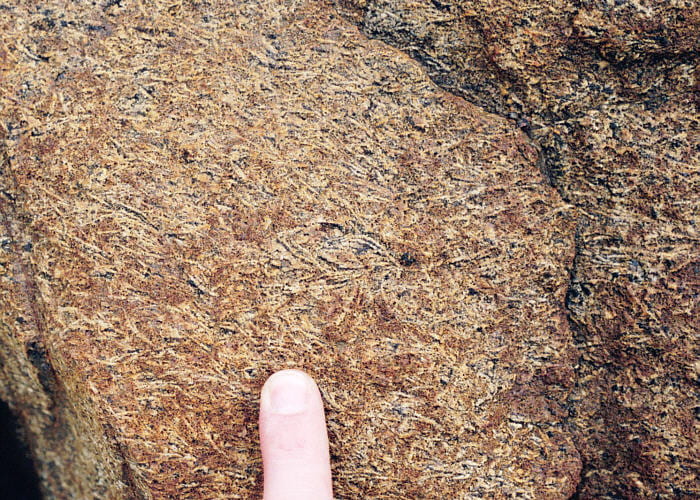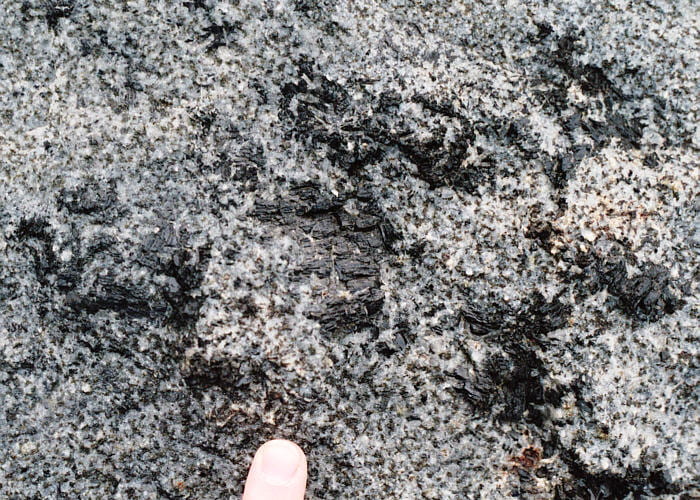The so-called “tranquil zone” is the steeply dipping Marginal Border Series (MBS) between the chilled margin (MBST) and the shallowly dipping Layered Series adjacent to and continuous with the MBS. Our tour of this region suggests that it was dominated by growth of crystals on the steeply dipping walls, principally as colliform layering on Mellemø and Ivnarmiut Islands. Perpendicular feldspar rock, wavy pyroxene rock, and possible slumps also occur in this zone. This zone was probably not particularly tranquil, but rather had fast-moving currents flowing down it.
Mellemø Island
Colliform layering is unique to the Marginal Border Series. It is not smooth and planar like that in the Layered Series, but instead is made up of inward-convex surfaces typically 0.5 to 2 m across with intervening, outward-pointing cusps. Vertical sections show that these layers are almost straight and parallel, so these colliform layers are essentially nested, vertically oriented corrugations of otherwise parallel continuous layers. I don’t know why the word “tranquil” was given to these rocks, but perhaps the concept is of smooth, downward-flowing convection currents, perhaps with the imagined sound of phenocrysts rustling against the walls.

Photos here and below are from Mellemø Island. Colliform layering, probably in the Marginal Border Series unit LZb*. The pluton interior is to the left, so this colliform layering has the rounded parts pointing inward, and the cusps pointing outward. These are growth features and not erosional.

Colliform layering also in LZb*. The layering here is nearly vertical.

Colliform layering in LZb*, with pegmatites close to the coliform margin. The pluton interior is to the right.

Looking southeast across the plateau on top of Mellemø Island, showing extensive, nearly vertical coliform layering in LZb* extending into the distance.
Ivnarmiut Island

Vertical cross section through steeply dipping colliform layers, showing that in this section the layers are nearly parallel. The colliform layers are therefore like parallel, nested celery stalks. There are replacement gabbroic pegmatites on the left and right.

Impressive colliform layering, showing the concentric layers that are nested growth structures.

Very nice colliform layering in LZb*, pluton center is to the right.
Perpendicular feldspar rock
This term refers to rock in the Marginal Border Series that has parallel or dendritic growths of plagioclase crystals that grew more or less perpendicular to the layer surfaces. It is not supposed that these crystals were growing far out into the liquid, but rather were probably growing at or very close to the solid surface. These feldspars tend to be more An-rich than the typical feldspars of the host rock.

Interesting texture of perpendicular feldspar rock in colliform layers, showing the perpendicular feldspars in one of the narrow colliform layer cusps, which are sharp compared to the convex parts but certainly not points. The feldspars crowd toward the center of the cusp. Very much like Figure 45 in Irvine et al. (2001b).

This photo is from Ivnarmiut Island. Perpendicular feldspar rock from the colliform layering section, from near the same location as the photo immediately.

Perpendicular feldspar rock ~10 m in from the Skaergaard contact with Archean gneisses. These probably grew very close to the rock-magma interface and probably did not protrude far into the magma. Here they grew in dendritic forms, rather than as straight single crystals. Maybe perpendicular feldspar rock represents the formal end of the contact or chilled zone and the start of the “Tranquil Zone” which, despite its name, appears to have had a lot of action.

More perpendicular feldspar rock from a few meters away from that in the photo above.

More perpendicular feldspar rock from a several meters farther into the pluton than the two photos above.

This is from southeastern Kraemer Island, showing the very common, dense and dendritic perpendicular feldspar rock in this area. That the feldspars are not quite so perpendicular here as in some places.
This photo is from Uttental Plateau. Perpendicular feldspars growing upward from the base of the scoured crossbed surface. Click on the left or right arrows to see the context of the perpendicular feldspars. In the second image, the perpendicular feldspar rock is at the base of the darkest layer.
Wavy pyroxene rock
This odd-looking texture is found in the Marginal Border Series, and is composed of numerous, small, typically sub-parallel, irregularly-elongated mafic pegmatite segregations in otherwise even-grained gabbro. These are from Mellemø Island. The host rock also has larger replacement mafic pegmatite bodies that are common throughout the pluton.

These first three are from Mellemø Island. This and the following photos are of wavy pyroxene rock, which here is an olivine gabbro with small, wavy, pegmatitic stringers within it. The pegmatitic waves contain abundant large pyroxenes. Bedding here is dipping down 70-80° to the east (left).
The host rock also has larger replacement mafic pegmatite bodies that are common throughout the pluton.

Close-up of one of the wavy pyroxene stringers, showing thin but irregular shape, large pyroxenes and plagioclase, and the matrix olivine gabbro.

More wavy pyroxene rock.

This one is from Ivnarmiut Island, showing large pyroxenes in wavy pyroxene rock ~10 m from the Skaergaard contact.

This is from southeastern Kraemer Island. Spectacular wavy pyroxene rock ~10 m inside the pluton margin at an elevation of ~70 m. Layering is nearly horizontal here, instead of vertical, possibly suggesting a ledge. There is a lot of perpendicular feldspar rock in this area.
Possible slump structure
Structures like this are found both in the Marginal Border Series and the Layered Series. This one has layers tightly folded over on one another, with the fold hinge in the up-slope direction.

This is from Mellemø Island. Apparent slump folds in the Tranquil Zone 20 or 30 m from the Skaergaard contact.


